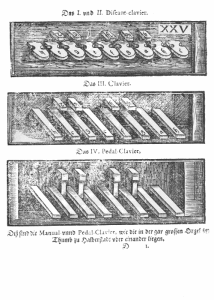Next Page: 2/8 Commas & Meantone Temperament
*Simple*
The Roman Catholic and Byzantine Churches
You must every man of you join in a choir so that being harmonious and in concord and taking the keynote of God in unison, you may sing with one voice through Jesus Christ to the Father, so that He may hear you and through your good deeds recognize that you are parts of His Son. – St. Ignacius to the Ephesians
By 300 A.D., the very early theorists of the Roman Catholic and Byzantine Churches diverged on their acceptance of five-limit harmonies. The Byzantines, influenced by Ptolemy, admitted fifth-harmonic relationships into their early chants. They also retuned Greek modes with elements of Turkish music that divided the whole tone into 9 parts (creating 53 unique pitches in an octave). Listen to Sister Marie Keyrouz’s chants to hear the emotionally expressive possibilities of chant sung in 5-limit tuning: https://www.youtube.com/watch?v=wdJSy9vXGNQ. It’s an interesting historical observation that while the Christian Churches spent centuries aggressively eradicating the pagan religions they encountered, they nevertheless embraced the pagan philosophy, culture, and musical traditions of the ancient Greeks. It’s a great relief that they did!
As far back as 300 A.D., Ambrosian Chant was developing in Milan hundreds of years before 7th Century Gregorian Chant from Rome took hold. Early Catholic medieval music theory was struggling with the simultaneity of competing tuning systems around all of Europe, from just ratios, to Pythagorean, to the Aristoxenian approximations by ear. The Catholic Church settled on strict, simple Pythagorean tuning. This remained the standard for a millennium. The ancient Catholics from both Rome and Milan went back to only the root, fourth, fifth and octave (3-limit intervals) as pure consonances. As you can hear in this Ambrosian Chant recording, 3-limit modes create a very different musical ambience. Check out this example if you are interested:
The early Catholic Church’s musical traditions evolved very slowly from Ambrosian/Gregorian Chant into an early polyphonic style known as Organum (900-1300 A.D., in full flower at Notre Dame in Paris). When motets gradually came into vogue around 1300, singers had to perform music of greater complexity, and singing the ratios of 5-limit music became more common. Theorists officially allowed thirds and sixths into their systems and defined them as consonances some 200 years after composers and performers were regularly employing them. Music became endowed with great emotional intensity during this Ars Nova period.
In 1361, Nicholas Faber created the first keyboard instrument, which, like frets on a lute, created a fixed system of twelve pitches.
The rediscovery of the writings of the Greek Harmonists and Ptolemy set the stage for the 16th century Venetian Gioseffe Zarlino to declare pure consonances to be based on the ratios one through six, what he called “the scenario.” Thus began the Renaissance chordal and harmonic traditions of what we call the “common practice” period. The evolution from 3-limit to 5-limit tuning did not change the fact that all musical scales and modes were still in alignment with the harmonic series. The leap away from this harmonic Eden did not take place until 1496, and it was the first of many tradeoffs musicians made between beauty and expediency.
If you would like to learn more about the 53-equal tuning that embraces all of ancient music, you can buy the entire book, The Grand Unified Theory of Music, in pdf form for $25 with hundreds of embedded musical examples of scales and chords from all over the world.
A free introduction to what The Grand Unified Theory of Music offers is on this website and includes both text and a few musical examples from each webpage. If you would like to learn more about this chapter and the full contents of this entire e-book, you can buy The Grand Unified Theory of Music for $25, with hundreds of embedded musical examples of scales and chords from all over the world — and ideas for how to set up your computer system —
HERE.
You’ll get a personalized password you can use to see the entire e-book. Inside the full book, you will also get a link to the complete pdf file of this e-book, which you can read on your Kindle or similar device. The links to the hundreds of mp3 sound files – the same ones you can hear on the website — will also be included. This is “Version 1.0” of The Grand Unified Theory of Music. Because it is an e-book, additions, corrections and improvements in the sound may be added at any time. The Grand Unified Theory of Music is Copyright © 2018 by Christopher Mohr. All rights reserved.
One person per password. Sharing this password with others is a violation of copyright. Do not allow others to use your password or link to the pdf file!

